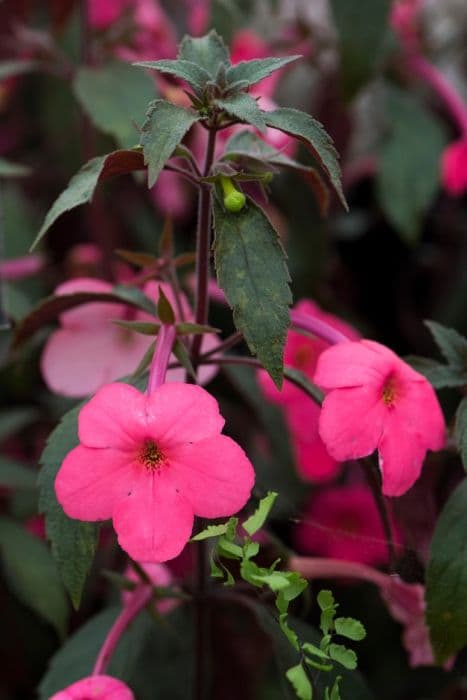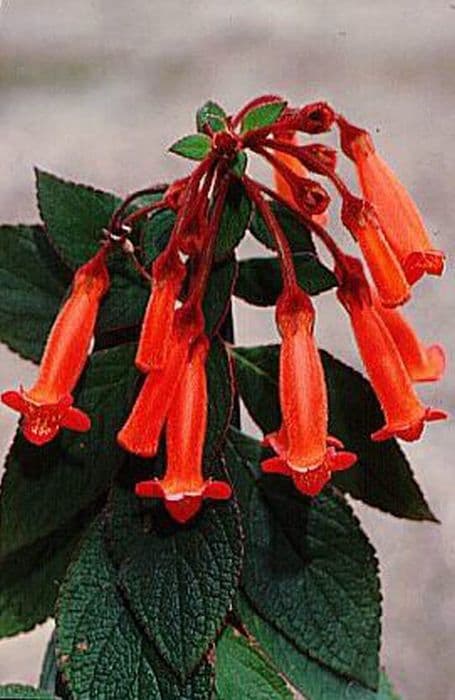Cape Primrose Streptocarpus 'Carys'

ABOUT
Streptocarpus 'Carys', commonly known as Cape Primrose, presents a lush display of foliage and striking flowers. The leaves are typically elongated and velvety, emerging in a rosette formation, creating a backdrop of deep green. The texture of the leaves is soft to the touch, often with a fine layer of downy hairs that can catch the light, giving them a slightly silvery appearance. The flowers of the Cape Primrose bloom with a radiance that is quite eye-catching. Each bloom features a blend of colors, often starting with a white or pale base that then merges into a rich, vibrant hue towards the lobed petals' edges. The petals might be adorned with contrasting patterns or streaks, usually in tones of purple, pink, or blue, adding depth and interest. These individual flowers are carried on slender, graceful stems, which arch subtlely as the blooms develop their full form. This variety of Cape Primrose is favored for its ornamental appeal, with its flowers creating a delicate yet impactful display. As a houseplant, it adds a splash of color and texture to any space without the need for extensive care. Overall, Streptocarpus 'Carys' encapsulates a harmonious blend of soft foliage and vibrant blooms that are aesthetically pleasing and charming in equal measure.
About this plant
 Names
NamesSynonyms
Cape Primrose, African Violet, Twisted Fruit.
Common names
Streptocarpus 'Carys'.
 Toxicity
ToxicityTo humans
Cape Primrose (Streptocarpus 'Carys') is generally not considered toxic to humans. It does not contain any known toxic compounds that pose a risk if touched or ingested. However, it is always advisable to keep plants out of reach of young children who might chew on them out of curiosity.
To pets
Cape Primrose (Streptocarpus 'Carys') is also not considered toxic to pets. It is not known to cause any adverse effects if ingested by cats, dogs, or other household pets. While it is safe, it's still a good practice to monitor pets around houseplants and prevent them from chewing on plants, as it can lead to digestive upset purely from the ingestion of non-digestible plant matter.
 Characteristics
CharacteristicsLife cycle
Perennials
Foliage type
Evergreen
Color of leaves
Green
Flower color
Mixed
Height
6-12 inches (15-30 cm)
Spread
12-18 inches (30-45 cm)
Plant type
Herb
Hardiness zones
10
Native area
Africa
Benefits
 General Benefits
General Benefits- Easy to care for: Streptocarpus, commonly known as Cape Primrose, is low maintenance and can thrive with minimal attention once established.
- Long blooming period: Cape Primrose is known for its ability to produce flowers for an extended period, often blooming for several months.
- Attractive foliage: The velvet-textured leaves add a lush, green backdrop to the colorful blossoms and contribute to the overall aesthetic appeal of the plant.
- Variety of colors: Blooms in a range of colors and patterns, providing an array of options to suit different tastes and decors.
- Compact size: Its small size makes it suitable for windowsills, tabletops, and small spaces.
- Indoor and outdoor versatility: Can be grown both indoors and outdoors (in the right climates), offering flexibility for gardeners.
- Hybrid vigor: As a hybrid, Carys often exhibits increased robustness and vitality compared to some non-hybrid species.
 Medical Properties
Medical PropertiesThis plant is not used for medical purposes.
 Air-purifying Qualities
Air-purifying QualitiesThis plant is not specifically known for air purifying qualities.
 Other Uses
Other Uses- Art Inspiration: Cape Primrose's vibrant colors and unique patterns provide inspiration for painters and other visual artists seeking to capture the beauty of nature.
- Educational Tool: Botany and horticulture teachers may use Cape Primrose to demonstrate plant propagation and floral structure to students.
- Photography Subject: With their appealing aesthetic, Cape Primrose can be favored subjects for photographers specializing in botanical images.
- Greeting Cards and Prints: Illustrations of Cape Primrose can adorn greeting cards and art prints for those who appreciate botanical themes.
- Fashion Design: The patterns and colors of Cape Primrose flowers can inspire fabric designs for the fashion industry.
- Wedding Decor: Because of their delicate appearance, Cape Primroses can be used in wedding bouquets and table decorations.
- Theme Gardens: Cape Primrose can be featured in theme gardens, such as Victorian or fairytale-inspired designs, adding color and charm.
- Container Gardening: Ideal for small spaces or urban gardening, Cape Primrose can be grown in containers to beautify balconies or patios.
- Plant Swap: Rare or unusual varieties of Cape Primrose can be sought after by collectors and exchanged in plant swap events.
- Crafting: Pressed flowers from the Cape Primrose can be used in crafting, such as creating bookmarks or decorating homemade candles.
Interesting Facts
 Feng Shui
Feng ShuiThe Cape Primrose is not used in Feng Shui practice.
 Zodiac Sign Compitability
Zodiac Sign CompitabilityThe Cape Primrose is not used in astrology practice.
 Plant Symbolism
Plant Symbolism- Enduring Love: As a member of the Gesneriaceae family, often known for their long-lasting flowers, the Cape primrose, which is a common name for Streptocarpus 'Carys', symbolizes enduring and persistent love, reflecting the plant's ability to bloom for extended periods.
- Hope and Good Fortune: The bright and attractive blooms of the Cape primrose are often considered symbols of hope and positive expectations, with the belief that they bring good fortune to the households they grace.
- Adaptability: Streptocarpus 'Carys' can thrive in a variety of conditions, symbolizing adaptability and the ability to prosper through life’s challenges.
 Water
WaterCape Primrose requires careful watering to thrive. It's best to water when the top inch of soil feels dry to the touch, typically once a week, but this may vary depending on environmental conditions like humidity and temperature. Use room temperature water, and pour it slowly onto the soil until it begins to run out of the bottom of the pot—this might be around 8-16 ounces for a standard indoor pot. Avoid wetting the leaves to prevent fungal diseases.
 Light
LightCape Primrose prefers bright, indirect light to bloom and grow healthily. A spot near an east or north-facing window is ideal as it provides the gentle morning sunlight without the harsh midday rays that can scorch the leaves. If only a south or west-facing window is available, use sheer curtains to diffuse the light.
 Temperature
TemperatureThe Cape Primrose fares best in moderate room temperatures, ideally between 60 and 70°F. It can survive minimum temperatures down to 50°F and maximum temperatures of about 80°F, though it is important to avoid sudden temperature changes. Keep the plant away from drafts and direct sources of heat or cold, like air conditioners or radiators.
 Pruning
PruningPruning the Cape Primrose encourages a bushier growth and more blooms. Remove dead or yellowing leaves as they appear and pinch off spent flower stems at their base to promote new growth. The best time for heavier pruning is in late winter or early spring, just before the plant enters its active growing phase.
 Cleaning
CleaningAs needed
 Soil
SoilCape Primrose 'Carys' thrives in a well-draining soil mix consisting of peat moss, perlite, and vermiculite in equal parts; maintain a soil pH of around 6.0 to 6.5.
 Repotting
RepottingCape Primrose 'Carys' should generally be repotted every 12 to 18 months or when it becomes root-bound.
 Humidity & Misting
Humidity & MistingCape Primrose 'Carys' prefers high humidity levels, ideally between 50% to 60%, for optimal growth.
 Suitable locations
Suitable locationsIndoor
Provide bright, indirect light and consistent moisture.
Outdoor
Shelter from direct sun; keep in dappled shade.
Hardiness zone
10-11 USDA
 Life cycle
Life cycleStreptocarpus 'Carys', commonly known as Cape Primrose, begins its life cycle with seed germination, typically in warm, moist soil conditions, where the tiny seeds develop into seedlings with a pair of initial leaves. As the seedlings mature, they grow a rosette of fuzzy, elongated leaves from which flower stalks emerge. The flowering stage is marked by the production of trumpet-shaped flowers that can show colors from blue to purple, often with intricate vein patterns or contrasting throats, blooming in succession over several months. After pollination, typically by insects, the plant produces elongated, twisting seed pods filled with numerous small seeds that, when matured, are released to start a new generation. Under favorable conditions, Cape Primrose can live for several years, producing flowers almost continuously if well cared for, with older leaves dying back as new ones emerge. During its life, Streptocarpus 'Carys' may also be propagated by leaf cuttings, which can root to form new plants, representing a vegetative stage of reproduction.
 Propogation
PropogationPropogation time
Spring-Early Summer
Streptocarpus 'Carys', commonly known as Cape Primrose, is best propagated by leaf cuttings, a method popular due to its simplicity and effectiveness. To propagate, a healthy leaf is selected, ideally during the plant’s active growing period, which is typically spring to early summer. The leaf is then cut across into sections, each with a vein. The cuttings are placed into a moist potting mix, vein side down, ensuring that the cut edge is just under the surface. The pot is then covered with plastic to retain humidity and placed in indirect light. In a few weeks, new shoots will emerge from the leaf sections. Once the shoots have developed into small plants, they can be separated and potted individually.









